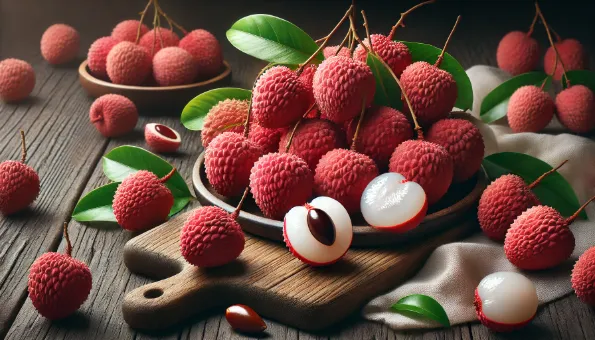Lychee: Juicy Tropical Fruit Rich in Vitamin C, Polyphenols & Floral Sweetness
Delicate white aril of *Litchi chinensis* with rose-like aroma, supplying vitamin C, hydration, light fiber and antioxidant polyphenols (epicatechin, procyanidins).

What Is Lychee?
Lychee (*Litchi chinensis*) is a small **subtropical drupe** with a thin, rough, red shell encasing a glossy dark seed and translucent white aril (the edible pulp). Flavor: sweet, floral (rose), lightly musky and gently acidic. Eaten fresh, canned in syrup, dried (‘lychee nuts’) or juiced.
Nutrition (per 100 g fresh pulp ~9–10 fruits)
| | Amount | %DV |
|---|---|---|
| Calories | 65–70 kcal | — |
| Carbohydrate | 16.5–17 g | — |
| – Sugars | 14–15 g | Natural fructose/glucose |
| Fiber | 1.3–1.5 g | 5 % |
| Protein | 0.8 g | — |
| Fat | 0.4 g | — |
| **Vitamin C** | 40–50 mg | 45–55 % |
| Vitamin B6, B2, Folate | Small | — |
| **Potassium** | 170–180 mg | 4 % |
| Copper | 0.15 mg | 17 % |
Hydration: ~82 % water. Dried lychee concentrates sugars & calories.
Bioactive Compounds
- **Vitamin C**: Primary antioxidant & collagen cofactor.
- **Polyphenols**: Epicatechin, procyanidins, quercetin derivatives—support antioxidant capacity.
- **Oligonol® (lychee polyphenol extracts)** studied for circulation & anti-fatigue (supplement form – not same as whole fruit).
- **Aroma volatiles**: Linalool & geraniol contribute floral character.
Potential Benefits
- **High vitamin C density** per calorie supports immune function & iron absorption in mixed meals.
- **Polyphenols + vitamin C** may aid oxidative stress balance.
- **Hydrating, light fiber** fruit snack vs refined sweets.
- Naturally **gluten-free, vegan**; pleasant sweetness can reduce desire for heavier desserts.
Drawbacks & Precautions
- **Natural sugars**: Portion mindfulness for low-sugar diets.
- **Unripe lychees** (particularly on empty stomach) have implicated **hypoglycin A & MCPG** toxins causing hypoglycemia in undernourished children—consume only ripe fruit and with food.
- Canned lychees in heavy syrup significantly raise sugar & calorie load—prefer fruit packed in juice or fresh.
- Rare allergy (oral itching) or cross-reactivity with other Sapindaceae (longan, rambutan).
Culinary Uses
- **Fresh**: Peel & deseed; add to fruit salads, yogurt, chia pudding.
- **Beverages**: Blend into smoothies, iced teas, cocktails/mocktails (pairs with lime, mint, ginger, coconut water).
- **Desserts**: Sorbets, granita, panna cotta topping, agar or gelatin jellies.
- **Savory**: Dice into spicy salads (with chili & herbs), pair with shellfish or light poultry for sweet-acid contrast.
- **Dried**: Chewy snack or rehydrate for compotes (watch concentrated sugars).
Selection & Handling
Choose **firm fruit with vibrant red to pink shell** (some browning OK; full brown often older). Avoid cracked, leaky, fermented aroma. Peel by snapping shell; remove seed. Serve chilled to accent floral freshness.
Health & Portion Guidance
- Typical portion: **½–1 cup (8–12 fruits)** provides ~30–55% DV vitamin C.
- Pair with **protein or healthy fat** (nuts, yogurt) to moderate glycemic response.
- Diabetics: monitor portion, pair with fiber-rich foods.
- Use ripe fruit; avoid consumption of numerous unripe lychees fasting (risk of acute hypoglycemia in vulnerable populations).
Storage
Highly perishable: Refrigerate in breathable bag; consume within 5–7 days. Do not wash until ready to eat. Can freeze peeled, pitted fruit (texture softens) for smoothies up to 3 months. Dried lychee store airtight in cool, dark place.
Key Takeaways
✔︎ Vitamin C & polyphenol-rich hydrating fruit
✔︎ Unique floral sweetness versatile in sweet & savory dishes
✖︎ Portion unripe fruit risk & added sugars in syrup—choose ripe fresh or lightly processed.
- 1. Lychee
Used in desserts and salads

